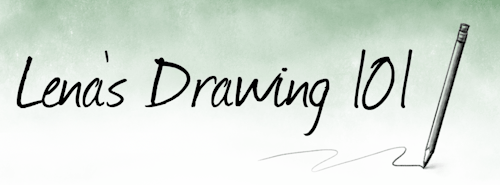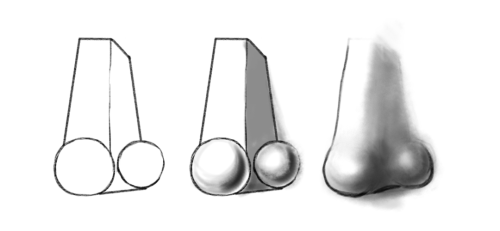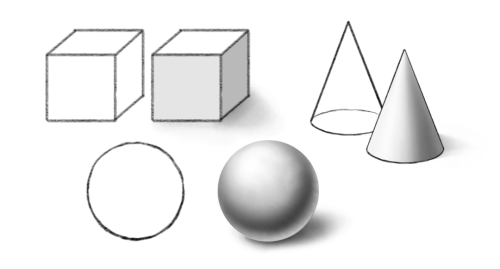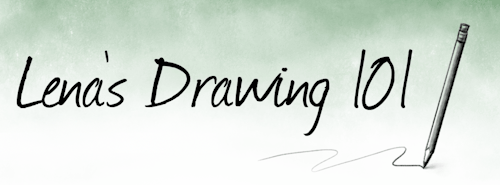Tumblr Cheering Drawings Easy Tumblr Drawings Easy

LESSON NINE: PERSPECTIVE
PART ONE - LINEAR PERSPECTIVE
We perceive things differently based on our relationship to them in space. I'm obviously not telling you anything new here – we can all observe the way objects farther away look smaller than objects that are very close to us.
Perspective drawing is a way of drawing the diminishing size of an object, or the diminishing distance between objects as they recede from the viewer in space, in such a way that the illusion of depth in three dimensions is present in a drawing.
Linear perspective is a type of perspective used by artists in which that relative size/shape/position is determined through the line of drawn or imagined converging lines.
A little history context: linear perspective in art first appeared in the western art tradition in the 14th century. Prior to that, works of art primarily portrayed a flattened view of space – seen below in ancient Egyptian, and medieval French art:

Compare these to the early Italian Renaissance – what differences do you notice?

Now, not every work needs to have a strong architectural component showcasing linear perspective – but a solid understanding of perspective will help you as an artist to work with issues of depth in any drawing where you are trying to realistically depict any subject in three-dimensional space.
Before we keep going, let's cover a few terms:
- Horizon Line - In any scene, there is a line where you, the viewer, will perceive the horizon. Obviously, you may not see the actual horizon (where the sky meets the earth) in every scene, since you're often, say, indoors, but in this case, we'll define the horizon line as your eye-level.
- Vanishing Point - A vanishing point is a point on the horizon line at which receding parallel lines viewed in perspective appear to converge.
- Orthogonal line - A line that recedes toward the vanishing point.
Ok? Now, let's get started with:
ONE POINT PERSPECTIVE
One-point perspective is so called because all orthogonals recede to a single vanishing point:

Keep reading
dappledwithshadow:
Albrecht Dürer
Albrecht Dürer was a painter, printmaker and theorist of the German Renaissance. Born in Nuremberg, Dürer established his reputation and influence across Europe when he was still in his twenties, due to his high-quality woodcut prints.
Born: May 21, 1471, Nuremberg, Germany
Died: April 6, 1528, Nuremberg, Germany
verdantbones:
Some floating ink skulls, drawn from two in my collection. Stippled coyote, and American marten skull.
Hello new followers!
Quite a few of you have started following me recently, so as a little bit of housekeeping:
Hi – I'm Lena, I run this blog, and I hope it's helpful for anyone learning to draw! (Or anyone who already has drawing skills who is looking to do a little refresh on the basics)
All my lesson posts, tangent posts, and Tips & Tricks posts are located here.
All posts reblogged from elsewhere on tumblr are tagged #reblogs.
You can ask me questions here (answered questions live here), or submit art for feedback. If you don't want to submit art publicly, but would like some private constructive critique, you're also welcome to message me! I will get back to you as soon as I am able.
I don't currently have a set schedule for when new lessons go up, but I am working on a series of posts about perspective next, so stay tuned.
Cheers!
-Lena

LESSON THREE: GETTING IN SHAPE(S)
Today's lesson will focus on geometric shapes and forms, and how to render them with light and shadow.
Now granted, very little of what you may want to draw will consist of perfect spheres, cubes, or cones. But almost every complex, organic shape? Can be reduced to basic geometric components. A nose might not be a standard geometric form, but you can build one by combining spheres for the tip of the nose and nostrils with a rectangular prism for the bridge – and if you know how to render and shade those forms, then shading a nose gets a lot easier.

Now, a sphere with no shading at all, just looks like a circle. It's a little easier with boxier shapes to convey 3-dimensionality just with contours, but it's still tricky sometimes to convey depth. You can convey a lot with just contours and linework, but we'll be talking about the technique involved in that in a later lesson. For today, dealing with light and shadow to communicate shape and depth will be our focus. We'll be concentrating mainly on simple geometric forms, because these are our building blocks for constructing more detailed, complex images as we feel more comfortable with our skills.

To start, let's make sure we have some terms defined:
Keep reading

LESSON TWO: DRAW WHAT YOU SEE,
NOT WHAT YOU THINK YOU SEE
The single most valuable art advice I have ever been given is "draw what you see, not what you think you see."
What does that mean?
Human beings love pictograms. We communicate effectively, across language barriers, by using icons and other visual shorthand to get ideas across. We're very good at this, because we have a knack for reducing a complex visual to a few minimal, key pieces of information, and then extrapolating from that minimal information by recognizing what it stands for.
For instance, we take the very complex image of a human face, with all its individually unique characteristics, specifically expressing happiness through muscle movements we know to associate with that emotion – flexing of the muscles around the mouth, showing of the teeth, but without upper lip curling, contraction of the muscles around the eyes – and we strip it down to two dots and a curving line:

We cannot tell looking at it who is happy; who is being depicted, whether they are old or young, male or female, anything about them – but we understand that that pictogram translates to someone smiling. The person who draws the smiley face does not draw what they have seen; they draw the idea of what they have seen. In this case, "happiness."
This is a pretty useful way to be wired. We recognize things quickly, and are able to reduce complex visual input to a few simple characteristics that we can remember.
But it's less useful to someone trying to learn to draw accurately and representationally.
When we draw, our instinct is to look at the object, recognize the object and apply those simplifications, and then record the simplifications. In doing so, we draw what our brain has already refined and coded, dropping 'unnecessary' details and hitting the checklist of items we think we need in order to recognize the subject matter (ie., the sun has yellow lines radiating out from it) – all without realizing that we're doing it. We draw what we think we see.
Keep reading
Source: https://drawing-with-lena.tumblr.com/
0 Response to "Tumblr Cheering Drawings Easy Tumblr Drawings Easy"
Post a Comment